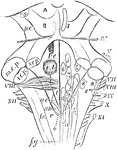Clipart tagged: ‘"ocular muscle"’

Fourth Ventricle with the Medulla Oblongata and the Corpora Quadrigemina
Fourth ventricle with the medulla oblongata and the corpora quadrigemina. The roman numbers indicate…

Pons
Diagram of a longitudinal section through the pons, showing the relation of the nuclei for the ocular…